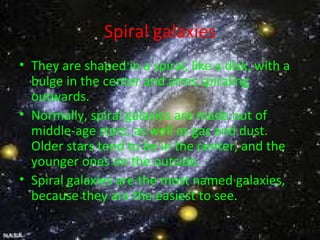Galaxies
- 2. Different types of galaxies Spiral galaxies Irregular galaxies Elliptical galaxies
- 3. Spiral galaxies They are shaped in a spiral, like a disk, with a bulge in the center and arms spiraling outwards. Normally, spiral galaxies are made out of middle-age stars, as well as gas and dust. Older stars tend to be in the center, and the younger ones on the outside. Spiral galaxies are the most named galaxies, because they are the easiest to see.
- 4. Irregular galaxies Irregular galaxies are made out of older stars, and have little gas and dust. They have no structured shape. They also can be classified by an irregular feature they have. Scientists estimate that irregular galaxies make up anywhere from 3 to 25% of the galaxies in the universe.
- 5. Elliptical galaxies This type of galaxy tends to be in a oval type shape. Normally, one side is longer then the other. This galaxy, has older stars, and have up to one trillion stars. The outer stars orbit the center, but in no pattern, each just randomly orbits. This galaxy is the biggest out of the types of galaxies, and the largest known one is 2 million light years long.
- 6. The Milky Way Galaxy The milky way galaxy is a spiral galaxy. It is much larger compared to most average size galaxies. The milky way is about ten times bigger in diameter then some average size galaxies. It has about 100 to 200 billion stars. If the Milky Way was a different galaxy, such as an irregular galaxy, we may not be able to know what the milky way looks like. There is very little gas and dust, so we wouldn’t have some of the same features that we have now. If it was an elliptical galaxy, are sun would be very old, and we may not have one. Also, we may not have an orbiting pattern, so we may not know if we will collide or not.
- 7. Project What I did for my proficiency is a power point, because I thought that this was the best way to get my information across, and the best way to present my information. I found the information, and set it up in an organized way. Some of the issues I had was finding out how the Milky Way compared to other galaxies, and how many galaxies of each type there were.
- 8. Citations " APOD: July 28, 1995 - M82: An Irregular Galaxy ." Astronomy Picture of the Day . N.p., n.d. Web. 5 Jan. 2011. <http://apod.nasa.gov/apod/ap950728.html>. "Elliptical galaxy - Wikipedia, the free encyclopedia." Wikipedia, the free encyclopedia . N.p., n.d. Web. 5 Jan. 2011. <http://en.wikipedia.org/wiki/Elliptical_galaxy>. "Elliptical galaxy - Wikipedia, the free encyclopedia." Wikipedia, the free encyclopedia . N.p., n.d. Web. 5 Jan. 2011. <http://en.wikipedia.org/wiki/Elliptical_galaxy>. "How Many Galaxies in the Universe." Universe Today . N.p., n.d. Web. 5 Jan. 2011. <http://www.universetoday.com/30305/how-many-galaxies-in-the-universe/>. " Milky Way Galaxy Much Larger Than Expected | Utah Skies." Utah Skies | Bringing the Joys of Astronomy to the Public Through Awareness, Advocacy, and Education . N.p., n.d. Web. 5 Jan. 2011. <http://www.utahskies.org/2009/01/07/1564/>. "Most Abundent Galaxies." Imagine The Universe! Home Page . N.p., n.d. Web. 5 Jan. 2011. <http://imagine.gsfc.nasa.gov/docs/ask_astro/answers/020130a.html>. "NASA Pictures of the Universe | Galaxies, Nebluae, Stars and More!." Geology.com - Earth Science News, Maps, Dictionary, Articles, Jobs . N.p., n.d. Web. 5 Jan. 2011. <http://geology.com/nasa/nasa-universe-pictures.shtml>. "What Is an Irregular Galaxy?." wiseGEEK: clear answers for common questions . N.p., n.d. Web. 5 Jan. 2011. <http://www.wisegeek.com/what-is-an-irregular-galaxy.htm>.







